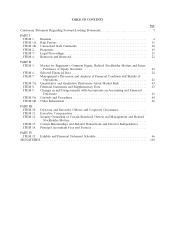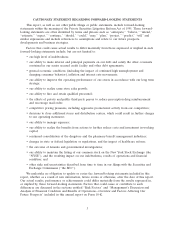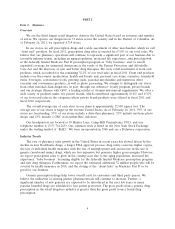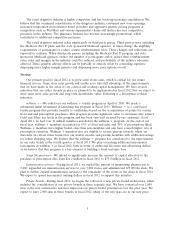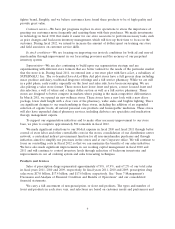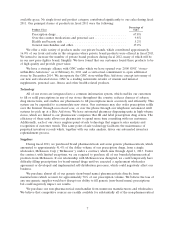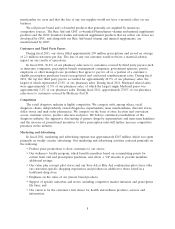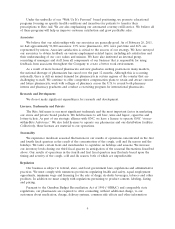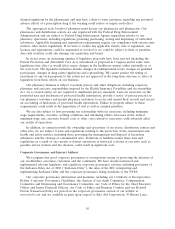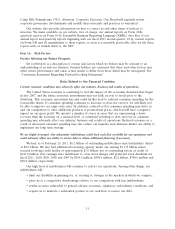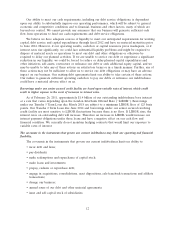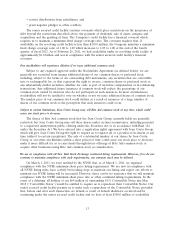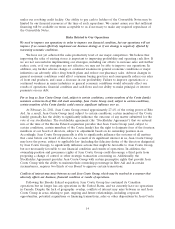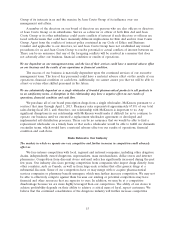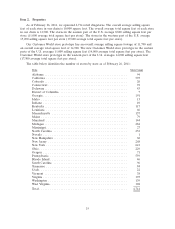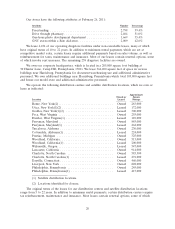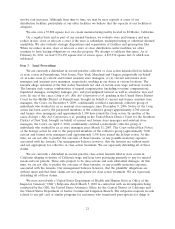Rite Aid 2011 Annual Report Download - page 12
Download and view the complete annual report
Please find page 12 of the 2011 Rite Aid annual report below. You can navigate through the pages in the report by either clicking on the pages listed below, or by using the keyword search tool below to find specific information within the annual report.Our ability to meet our cash requirements, including our debt service obligations, is dependent
upon our ability to substantially improve our operating performance, which will be subject to general
economic and competitive conditions and to financial, business and other factors, many of which are
beyond our control. We cannot provide any assurance that our business will generate sufficient cash
flow from operations to fund our cash requirements and debt service obligations.
We believe we have adequate sources of liquidity to meet our anticipated requirements for working
capital, debt service and capital expenditures through fiscal 2012 and have no material maturities prior
to June 2014. However, if our operating results, cash flow or capital resources prove inadequate, or if
interest rates rise significantly, we could face substantial liquidity problems and might be required to
dispose of material assets or operations to meet our debt and other obligations or otherwise be
required to delay our planned activities. If we are unable to service our debt or experience a significant
reduction in our liquidity, we could be forced to reduce or delay planned capital expenditures and
other initiatives, sell assets, restructure or refinance our debt or seek additional equity capital, and we
may be unable to take any of these actions on satisfactory terms or in a timely manner. Further, any of
these actions may not be sufficient to allow us to service our debt obligations or may have an adverse
impact on our business. Our existing debt agreements limit our ability to take certain of these actions.
Our failure to generate sufficient operating cash flow to pay our debts or refinance our indebtedness
could have a material adverse effect on us.
Borrowings under our senior secured credit facility are based upon variable rates of interest, which could
result in higher expense in the event of increases in interest rates.
As of February 26, 2011, approximately $1.4 billion of our outstanding indebtedness bore interest
at a rate that varies depending upon the London Interbank Offered Rate (‘‘LIBOR’’). Borrowings
under our Tranche 5 Term Loan due March 2018 are subject to a minimum LIBOR floor of 125 basis
points. Our Tranche 2 Term Loan due June 2014 and borrowings under our senior secured revolving
credit facility are most sensitive to LIBOR fluctuations because there is no floor. If LIBOR rises, the
interest rates on outstanding debt will increase. Therefore an increase in LIBOR would increase our
interest payment obligations under those loans and have a negative effect on our cash flow and
financial condition. We currently do not maintain hedging contracts that would limit our exposure to
variable rates of interest.
The covenants in the instruments that govern our current indebtedness may limit our operating and financial
flexibility.
The covenants in the instruments that govern our current indebtedness limit our ability to:
• incur debt and liens;
• pay dividends;
• make redemptions and repurchases of capital stock;
• make loans and investments;
• prepay, redeem or repurchase debt;
• engage in acquisitions, consolidations, asset dispositions, sale-leaseback transactions and affiliate
transactions;
• change our business;
• amend some of our debt and other material agreements;
• issue and sell capital stock of subsidiaries;
12


